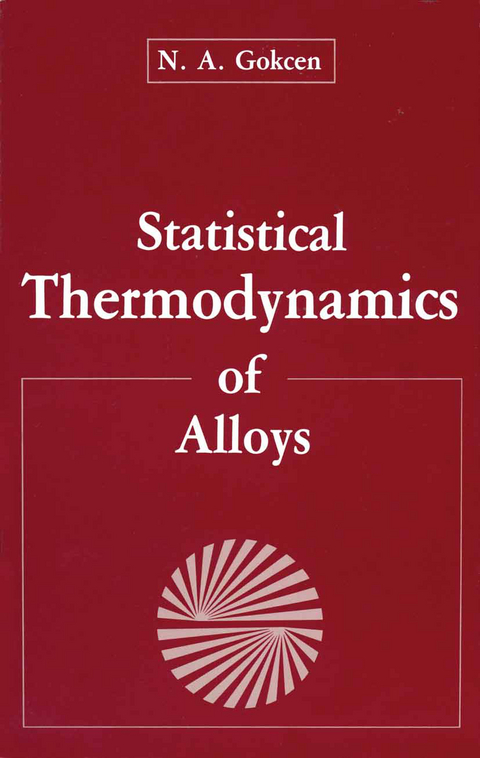
Statistical Thermodynamics of Alloys
Springer-Verlag New York Inc.
978-1-4684-5055-2 (ISBN)
This book is intended for scientists, researchers, and graduate students interested in solutions in general, and solutions of metals in particular. Readers are assumed to have a good background in thermodynamics, presented in such books as those cited at the end of Chapter 1, "Thermo dynamic Background." The contents of the book are limited to the solutions of metals + metals, and metals + metalloids, but the results are also appli cable to numerous other types of solutions encountered by metallurgists, materials scientists, geologists, ceramists, and chemists. Attempts have been made to cover each topic in depth with numerical examples whenever necessary. Chapter 2 presents phase equilibria and phase diagrams as related to the thermodynamics of solutions. The emphasis is on the binary diagrams since the ternary diagrams can be understood in terms of the binary diagrams coupled with the phase rule, and the Gibbs energies of mixing. The cal culation of thermodynamic properties from the phase diagrams is not emphasized because such a procedure generally yields mediocre results. Nevertheless, the reader can readily obtain thermodynamic data from phase diagrams by reversing the detailed process of calculation of phase diagrams from thermodynamic data. Empirical rules on phase stability are given in this chapter for a brief and clear understanding of the physical and atomistic factors underlying the alloy phase formation.
1 Thermodynamic Background.- Consequences of Laws of Thermodynamics.- Helmholtz and Gibbs Energies.- Partial Molar Gibbs Energy.- Activity.- Variation of Activity with Pressure and Temperature.- Depression and Elevation of Freezing Point.- Molar Properties.- Excess Molar Properties.- Analytical Forms of Excess Partial Molar Properties.- Determination of Ge and $$ /overline G _i^e $$ of Ternary Systems.- Interaction Parameters.- Other Definitions of Partial Molar Gibbs Energy.- References.- 2 Phase Equilibria and Phase Diagrams.- Single-Component Equilibria.- Multicomponent Equilibria.- Phase Rule.- Phase Diagrams.- Erroneous Diagrams.- Lever Rule.- Molar Gibbs Energy of Mixing—Phase Diagrams.- ?G Diagrams for Other Phases.- ?G Diagrams for Complex Systems.- Calculation of Phase Diagrams from Thermodynamic Data.- Empirical Rules on Phase Stability.- References.- 3 Statistical Thermodynamics.- Distribution of Independent Particles.- Fermi-Dirac Statistics.- Bose-Einstein Statistics.- Boltzmann Statistics.- Distribution Laws.- Entropy and Related Properties.- Fermions, Bosons, and Boltzons.- Gibbsian Ensembles.- Vibrations of Atoms in Lattices.- Potential Energy Functions.- References.- 4 Theories of Solutions.- Regular Solutions—Zeroth Approximation.- Preliminary Concepts.- Distribution of Molecules.- Equations.- First Approximation.- Approximate Equations.- Dilute Binary Regular Solutions.- Critique of Treatments Based on Permutation of Bonds.- Ternary Regular Solutions.- Regular Associated Solutions.- References.- 5 Long-Range Order.- Ordering and Clustering.- Order-Disorder in Binary Alloys.- Long-Range Order Parameter.- Gorsky, and Bragg and Williams (GBW) Approximation.- Heat Capacity.- More General Cases.- First Approximation.- Enthalpy and Heat Capacity.-Comments on Previous Approximations.- Unequal Numbers of Atoms and Equal Numbers of Sites.- References.- 6 Interstitial Solutions.- Pd-H System.- Statistical Treatment, Zeroth Approximation.- Solid Interstitial Solutes.- Application to Pd-H System.- Other Hydrogen-Metal Systems.- Hydrogen Storage.- Hydrogen Storage Metals and Alloys.- Ti, Zr, Hf and Their Alloys.- Fe-C System.- Wagner Model for Ternary Interstitial Alloys.- Application of Equation (6.106).- Limitations of Wagner Model.- References.- 7 Semiconductors.- Distribution of Electrons.- Motion of Electrons and Holes.- Dopants in Semiconductors.- Energy of Electrons and Holes.- Concentration of Electrons.- Concentration of Holes.- Equilibrium Constant for Charge Carriers.- Correlation of Band-Gap Data.- Derived Thermodynamic Properties.- Ionization Equilibria.- Fermi Energy in Doped Semiconductors.- p-n Junctions.- Effects of Applied Current on p-n Junctions.- Solar Cells.- Simple Equivalent Circuit.- Tandem Solar Cells.- Calculation Procedure.- References.- Appendix A Engel-Brewer Theories.- Basic Principles.- Nonintegral Electronic Configurations.- Transition Elements.- Correlation of Bonding Energies.- Electron Concentration Ranges in Alloys.- Effect of Pressure.- Multicomponent Diagrams.- Concluding Remarks.- Appendix B Estimation of Enthalpy of Alloy Formation.- Empirical Coefficients.- Alloys of Hydrogen.- Ternary Hydrides.- Ternary and Multicomponent Alloys.- Concluding Remarks.- Appendix C Correlation of Thermodynamic Properties in Dilute Solutions.- Appendix D Selected Properties of the Elements.- Appendix E Selected Binary Phase Diagrams and Binary Thermodynamic Properties.- Appendix F List of Symbols.- Appendix G Periodic Table (Mendeleev Table of the Elements).
| Zusatzinfo | 342 p. |
|---|---|
| Verlagsort | New York, NY |
| Sprache | englisch |
| Maße | 152 x 229 mm |
| Themenwelt | Sachbuch/Ratgeber ► Natur / Technik ► Garten |
| Naturwissenschaften ► Chemie ► Physikalische Chemie | |
| Naturwissenschaften ► Physik / Astronomie ► Thermodynamik | |
| Technik ► Maschinenbau | |
| ISBN-10 | 1-4684-5055-7 / 1468450557 |
| ISBN-13 | 978-1-4684-5055-2 / 9781468450552 |
| Zustand | Neuware |
| Informationen gemäß Produktsicherheitsverordnung (GPSR) | |
| Haben Sie eine Frage zum Produkt? |
aus dem Bereich


